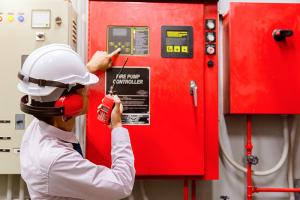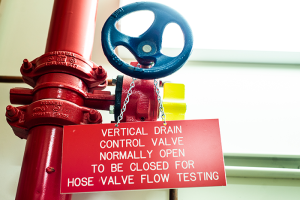Optimizing hospital HVAC systems
Engineering site assessments often point to HVAC systems when it comes to high energy use. By optimizing the HVAC system, health facility managers can address two of the biggest challenges for any health care campus: providing the resiliency to protect patients and sensitive environments, and shrinking the facility’s carbon footprint.
An optimized system always operates at peak efficiency, so hospitals save on utility costs and use less water. HVAC optimization also provides a more flexible, resilient chiller plant and helps managers maximize their operational budget, minimize downtime and maintenance costs, and do more with their existing staff.
The potential benefit of optimization is difficult to overstate. For example, a campuswide optimization project saved a Pennsylvania hospital almost 4.2 gigawatt-hour (GWh) a year in energy — far more than the 1 GWh predicted by the initial engineering site assessment. Overall campus energy intensity dropped 4%, so the hospital is spending about $300,000 less on electricity every year. The staff invested much of those early savings back into the chiller plant to replace outdated equipment with modern, high-efficiency components.
Precision controls
Whether it’s a heat wave or precise temperature requirements that’s taxing the system’s cooling powers, optimization ensures that the hospital can adapt nimbly to provide the precise temperature and environmental conditions that ensure patient health and safety — while also controlling cost and energy use.
For example, doctors need their operating rooms (ORs) to be immediately ready for procedures that may have vastly different environmental requirements: general surgeons may prefer the OR to be 74 degrees with 60% humidity, while cardiac specialists require it to be a full 10 degrees cooler.
At a children’s hospital in Washington, the optimized HVAC system enables the hospital to quickly drop the temperature of a particular OR immediately when needed. This allows the hospital to maintain ORs at the higher temperature, so the system uses far less energy than if it had to constantly keep all ORs cool enough for the rare pediatric heart surgery.
In a different scenario, a Tennessee health care facility with a co-located regional data center believed that because uninterrupted operation of the data center was critical, an optimization project was not possible. (A previous cooling failure had caused a forced shutdown of the data center.) However, the site assessment and proposal showed the project would ultimately improve reliability for the data center as well as the facility. And the savings for the last year (more than $160,000) have allowed the facility to continue investing in resiliency measures, further assuring the data center’s operational integrity.
Infrastructure flexibility
Optimization also allows the HVAC system to operate efficiently within a wider range of flows and conditions. And, if some of the plant’s equipment goes down, the system can automatically compensate and maintain patient comfort and safety.
For example, when a San Diego–area medical facility lost one of its three chillers, the optimized system continued to operate effectively and patients were none the warmer. The two chillers could provide more cooling than their design because optimization enabled more effective heat transfer.
Also, optimization software provides automated responses to rare or short-duration events. At one university hospital, the system flagged that there were occupants in an office wing early in the day for a short time, so the software was programmed so the system would automatically accommodate that one daily event.
Proactive maintenance
Unlike a building automation system (BAS), which sounds the alarm only after equipment fails, optimization software can flag issues before a failure occurs. In fact, it acts as an early warning system, sending emails or texts to staff on their smartphones when equipment such as a fan, pump or chiller is operating outside expected parameters.
At the same time, software monitoring tools can minimize HVAC infrastructure downtime and reduce maintenance costs. Staff can spot problems early and address them when it makes most sense for the hospital’s operations, rather than having to deal with these issues on an emergency basis.
In New Hampshire, automated compliance alarms alerted facility team members to a malfunctioning BAS before they noticed there was a problem, and the vendor fixed the BAS before anyone was affected. Similarly, a Cincinnati hospital discovered and resolved a problem with a condensing water pump before it escalated into a system-breaking calamity.
A hospital in Texas takes this one step further: they use monthly equipment performance reports and overall system metrics to plan operations and prioritize the vendors with which they will work in the upcoming month.
Budget flexibility
HVAC optimization can give facilities teams some wiggle room in the budget, particularly if they’re looking to squeeze additional capacity from existing plants. Depending on its needs, a health care facility can use HVAC optimization to postpone or even entirely avoid expanding its cooling capacity (i.e., purchasing another chiller). By increasing the efficiency of their chiller plants, hospitals can extend cooling loads, providing air conditioning to more space without increasing energy costs.
Other hospitals invest the money that plant optimization saves in adding equipment or upgrading to high-efficiency models. When a South Carolina health care organization began looking at chilled water plant optimization, it chose one plant as a test project. The first 15 months of fully optimized operations saved more than $450,000 — enough to pay for the original project and optimize a second HVAC plant.
Another health care facility team demonstrated the savings impact of its optimization efforts to gain approval to replace its 20-year-old chillers with state-of-the-art magnetic levitation chillers. Ultimately, the new equipment saved even more energy and reduced plant operating and maintenance costs.
Maximized teams
HVAC optimization can make the facilities team more resilient and effective. Staff can accomplish more because they are freed from responding to unexpected incidents or manually checking system performance. They can move from a reactive mode to a proactive mode and work on higher-value strategic projects.
Perhaps the best example comes from a hospital in Pennsylvania, which uses charting and trending data to cut its equipment check walk-through from 2 hours per shift (6 hours per day) into a 30-minute data dive twice a day, plus a traditional walk-through once a week. The staff gained 30 hours a week, which they now spend reviewing identified problems, working out solutions and obtaining better vendor bids.
In addition, the facilities team can program tribal knowledge into the HVAC system. The loss of one key employee — such as the one person who knew how to set the chiller override for that one 115-degree day each summer — will no longer cripple the team.
Best practices
To achieve the strongest results, project leaders should make sure the following critical elements are in place.
- An effective optimization solution. The system should provide thorough measurement of sensor data and energy use; take a holistic approach to ensure the entire system is optimized rather than just individual components; and deliver continuous and automatic feedback to the HVAC system.
- Protection for operational requirements. Facility operators need to be confident that operational requirements will continue to be met when optimization is active. An optimization provider should conduct a thorough feasibility study to determine the operational requirements, savings, project scope, costs and return on investment for the project.
- Full-system testing. It is critical that the team install and set up all parts of the optimization project properly so that the whole system works as intended.
- Robust measurement and verification. Finally, the optimization product should provide ongoing M&V to ensure that the system is meeting energy savings targets.
No small undertaking
Optimizing HVAC systems is no small undertaking — systems can never be powered down; and the project may require resetting water chillers, switching to variable-speed components, or repiping the plant in addition to installing control software.
While the cost and energy savings alone can be worth the effort and investment, the most successful HVAC optimization projects have the future in mind. They redirect the facilities staff toward strategic projects and give campus operations a resilient, responsive system that saves resources and supports sustainability goals.
Eric Peltier is the senior technical account manager at Optimum Energy LLC, Seattle. He can be reached at eric.peltier@optimumenergyco.com.




